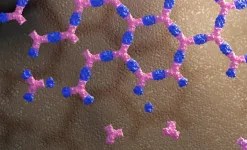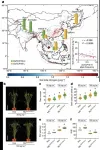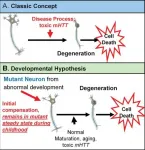(Press-News.org) Researchers have successfully used a DNA-editing technique to extend the lifespan of mice with the genetic variation associated with progeria, a rare genetic disease that causes extreme premature aging in children and can significantly shorten their life expectancy. The study was published in the journal Nature, and was a collaboration between the National Human Genome Research Institute (NHGRI), part of the National Institutes of Health; Broad Institute of Harvard and MIT, Boston; and the Vanderbilt University Medical Center, Nashville, Tennessee.?
DNA is made up of four chemical bases -- A, C, G and T. Progeria, which is also known as Hutchinson-Gilford progeria syndrome, is caused by a mutation in the nuclear lamin A?(LMNA) gene in which one DNA base C is changed to a T. This change increases the production of the toxic protein progerin, which causes the rapid aging process.
Approximately 1 in 4 million children are diagnosed with progeria within the first two years of birth, and virtually all of these children develop health issues in childhood and adolescence that are normally associated with old age, including cardiovascular disease (heart attacks and strokes), hair loss, skeletal problems, subcutaneous fat loss and hardened skin.
For this study, researchers used a breakthrough DNA-editing technique called base editing, which substitutes a single DNA letter for another without damaging the DNA, to study how changing this mutation might affect progeria-like symptoms in mice.
"The toll of this devastating illness on affected children and their families cannot be overstated," said Francis S. Collins, M.D., Ph.D., a senior investigator in NHGRI's Medical Genomics and Metabolic Genetics Branch, NIH director and a corresponding author on the paper. "The fact that a single specific mutation causes the disease in nearly all affected children made us realize that we might have tools to fix the root cause. These tools could only be developed thanks to long-term investments in basic genomics research."
The study follows another recent milestone for progeria research, as the U.S. Food and Drug Administration approved the first treatment for progeria in November 2020, a drug called lonafarnib. The drug therapy provides some life extension, but it is not a cure. The DNA-editing method may provide an additional and even more dramatic treatment option in the future.
David Liu, Ph.D., and his lab at the Broad Institute developed the base-editing method in 2016, funded in part by NHGRI.
"CRISPR editing, while revolutionary, cannot yet make precise DNA changes in many kinds of cells," said Dr. Liu, a senior author on the paper. "The base-editing technique we've developed is like a find-and-replace function in a word processor. It is extremely efficient in converting one base pair to another, which we believed would be powerful in treating a disease like progeria."
To test the effectiveness of their base-editing method, the team initially collaborated with the Progeria Research Foundation to obtain connective tissue cells from progeria patients. The team used the base editor on the?LMNA?gene within the patients' cells in a laboratory setting. The treatment fixed the mutation in 90% of the cells.
"The Progeria Research Foundation was thrilled to collaborate on this seminal study with Dr. Collins's group at the NIH and Dr. Liu's group at Broad Institute," said Leslie Gordon, M.D., Ph.D., a co-author and medical director of The Progeria Research Foundation, which partially funded the study. "These study results present an exciting new pathway for investigation into new treatments and the cure for children with progeria."
Following this success, the researchers tested the gene-editing technique by delivering a single intravenous injection of the DNA-editing mix into nearly a dozen mice with the progeria-causing mutation soon after birth. The gene editor successfully restored the normal DNA sequence of the?LMNA?gene in a significant percentage of cells in various organs, including the heart and aorta.
Many of the mice cell types still maintained the corrected DNA sequence six months after the treatment. In the aorta, the results were even better than expected, as the edited cells seemed to have replaced those that carried the progeria mutation and dropped out from early deterioration. Most dramatically, the treated mice's lifespan increased from seven months to almost 1.5 years. The average normal lifespan of the mice used in the study is two years.
"As a physician-scientist, it's incredibly exciting to think that an idea you've been working on in the laboratory might actually have therapeutic benefit," said Jonathan D. Brown, M.D., assistant professor of medicine in the Division of Cardiovascular Medicine at Vanderbilt University Medical Center. "Ultimately our goal will be to try to develop this for humans, but there are additional key questions that we need to first address in these model systems."
INFORMATION:
Funding for the study was supported in part by NHGRI, the NIH Common Fund, the National Institute of Allergy and Infectious Diseases, the National Institute of Biomedical Imaging and Engineering, the National Institute of General Medical Sciences, the National Heart, Lung and Blood Institute and the National Center for Advancing Translational Sciences.
A new class of protein material that interacts with living cells without being absorbed by them can influence cell signaling, a new study shows. The material does this by binding and sequestering cell surface receptors.
The discovery could have far-reaching implications for stem cell research and enable the development of new materials designed to modulate the behavior of living systems.
The research, reported in the January 6 edition of Nature, was led by the Baker lab at the University of Washington School of Medicine and the Derivery lab at the Medical Research Council Laboratory of Molecular Biology in Cambridge, U.K. Their paper is titled, Design of Biologically Active Binary Protein 2D Materials.
Cells ...
The westerlies--or westerly winds--play an important role in weather and climate both locally and on a global scale, by influencing precipitation patterns, impacting ocean circulation and steering tropical cyclones. So, finding a way to assess how they will change as the climate warms is crucial.
Typically, the westerlies blow from west to east across the planet's middle latitudes. But scientists have noticed that over the last several decades, these winds are changing, migrating poleward. Research suggests this is because of climate change. But, scientists have been debating whether the poleward movement of ...
What The Study Did: The findings of this survey study suggest that simply providing maps with COVID-19 case information wasn't necessarily associated with improved public knowledge, risk perception or reported intent to adhere to health guidelines.
Authors: Angela Fagerlin, Ph.D., of the University of Utah in Salt Lake City, is the corresponding author.
To access the embargoed study: Visit our For The Media website at this link https://media.jamanetwork.com/
(doi:10.1001/jamanetworkopen.2020.33538)
Editor's Note: The article includes conflict of interest disclosures. Please see the article for additional ...
What The Study Did: Changes in out-of-hospital cardiac arrests and fatalities in the Detroit area during the COVID-19 pandemic are compared with year-earlier events for the same period in this observational study.
Authors: Adrienne V. Nickles, M.P.H., of the Michigan Department of Health and Human Services in Lansing, is the corresponding author.
To access the embargoed study: Visit our For The Media website at this link https://media.jamanetwork.com/
(doi:10.1001/jamanetworkopen.2020.32331)
Editor's Note: The article includes conflict of interest disclosures. Please see the article for additional information, including other authors, author contributions and affiliations, conflict of interest and financial disclosures, and funding and support.
INFORMATION:
Media ...
Writing, driving a screw or throwing darts are only some of the activities that demand a high level of skill. How the brain masters such exquisite movements has now been described in the journal "Nature" by a team of researchers at the University of Basel and the Friedrich Miescher Institute for Biomedical Research. A map of brainstem circuits reveals which neurons control the fine motor skills of the arm and hand.
Picking up a pen and writing our name or reaching for a fork to eat spaghetti with tomato sauce are things we take for granted. However, holding a pen properly or bringing spaghetti to the mouth without making a mess requires precise ...
Chinese scientists from the Institute of Genetics and Developmental Biology of the Chinese Academy of Sciences (CAS) have found a gene that plays an important role in helping rice adapt to low soil nitrogen.
Nitrogen fertilizer application is a strategic challenge for sustainable agriculture: On the one hand, it plays an indispensable role in increasing crop yields, thus ensuring global food security. On the other hand, it creates a severe threat to ecosystems. For this reason, breeding new crop varieties with high nitrogen use efficiency (NUE) is a high priority for both agricultural production and environmental protection.
Using a diversified rice population derived from different ecogeographical regions, the scientists carefully evaluated how various agronomic traits responded to ...
Chinese scientists have established the world's first integrated quantum communication network, combining over 700 optical fibers on the ground with two ground-to-satellite links to achieve quantum key distribution over a total distance of 4,600 kilometers for users across the country. The team, led by Jianwei Pan, Yuao Chen, Chengzhi Peng from the University of Science and Technology of China in Hefei, reported in Nature their latest advances towards the global, practical application of such a network for future communications.
Unlike conventional encryption, quantum communication is considered ...
SYRACUSE, N.Y. - There's no doubt the Earth's temperatures are going up. According to a December report by the World Meteorological Organization, 2020 is on track to be one of the three hottest years on record, already within the warmest decade to date. During the year's hottest months, many people rely on electricity-generated cooling systems to remain comfortable. But the power plants that keep air conditioners pushing out cold air could soon be in a vicious cycle in a warming world-not able to keep up with growing demands on hotter days and driving up greenhouse gas emissions ...
Amsterdam, NL, January 6, 2021 - There is growing evidence to support the hypothesis that there is a neurodevelopmental component to the late-onset neurodegeneration occurring in the brain of huntingtin gene (HTT gene) mutation carriers, and that this increased susceptibility to brain cell death begins during childhood. Experts discuss the evidence that the HTT gene mutation affects brain and body growth based on a unique study of children at risk for HD, the Kids-HD study, in a review paper and accompanying research article published in the Journal of Huntington's Disease.
The classic concept is that Huntington's disease is caused by toxic mutant huntingtin (mHTT) acting over time on mature brain cells. However, there is growing evidence for an alternative ...
Engineers at the University of Maryland (UMD) have created a new shape-changing or "morphing" 3D printing nozzle that was featured as a Frontispiece in the January 5th issue of the journal Advanced Materials Technologies.
The team's morphing nozzle offers researchers new means for 3D printing "fiber-filled composites" - materials made up of short fibers that boost special properties over traditional 3D-printed parts, such as enhancing part strength or electrical conductivity. The challenge is that these properties are based on the directions or "orientations" of the short fibers, which has been difficult to control during the 3D printing process, until now.
"When 3D printing with the morphing nozzle, the power lies on ...








